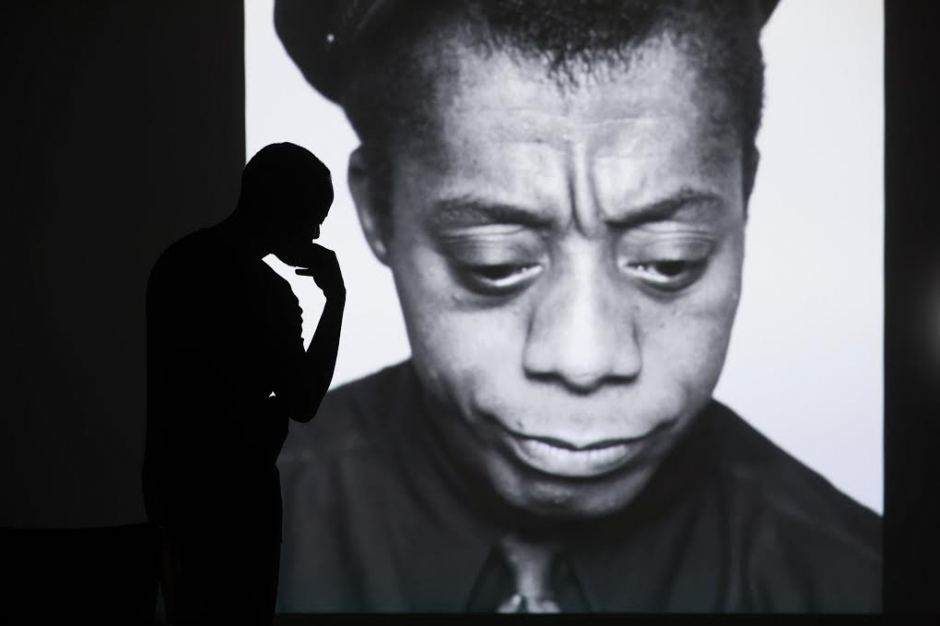Ogutu Muraya presents Fractured Memory, HOME; March 16 2017.
‘How can one deal with an inherited history that is full of complexity?’ Ogutu Muraya asks in the blurb to Fractured Memory. The performance’s response seems to be: through complexity itself. Employing an astounding range of technical and formal mediums, Ogutu weaves together an assortment of disparate narratives in order to present a piece that retains and reinforces the complexity of its subject matter.
The piece is inspired by James Baldwin’s remarkable ‘Princes and Powers’ (1957) essay, which recounts the 1956 Conference of Negro-African Writers and Artists at the Sorbonne in Paris. Throughout the essay, Baldwin inhabits a series of voices, placing them in montage in order to portray the variety of opinions present and the intensity of the discussions generated. In a similar way, Ogutu’s range of visual and audio techniques acknowledges the complexity of his subject matter. Not only does he preserve the sense of dialogism imbued within Baldwin’s piece, but, by introducing new narratives, Ogutu extends the text, adding new layers to the subject matter being addressed. The 1997 elections in Kenya provide a new political context, while the personal history of a Kenyan family is offered in a captivating live performance.
Ogutu is a compelling storyteller. At several key moments in the piece, he addresses the audience directly, describing a series of encounters in which he and his father attempt to regain power from the white colonisers they are confronted with. His performance peaks at two highly visceral moments. In the first of these, he vehemently coughs up the phlegm which he spits into the white diner’s food. In the second, he performs his father’s booming laugh in the face of a white man’s attire – a laughter which reappeared as an echo later in the performance and which continued to echo in the audience’s ears after the show.
These moments of live narration contrast with the opening of the show, where extracts from Baldwin’s essay appear as text on the screen. The absence of any audio accompaniment during this section introduces silence as an important tool used throughout this piece. In this opening section, the silence allows the audience to focus on the text, reading the words on the screen as they would have appeared in Baldwin’s essay. In foregrounding Baldwin’s words, Ogutu seems to be attempting to preserve the moment of history that Baldwin captures in his essay and to redeploy this history in a pure and uncorrupted way.
However, Ogutu’s fidelity to both the form and content of Baldwin’s essay is brought into question by the black and white film footage that reappears at key moments throughout the performance, showing a pair of hands cutting up sections of text. While the text presented here is not from Baldwin’s essay, but instead appears to be publicity materials from the Kenyan election, the appearance of the black and white writing reminds the audience of the quotations from the essay earlier in the performance. Self-consciously highlighting the process through which words are selected and omitted in order to construct and deconstruct of meanings, this footage encourages the viewer to reconsider the function of Baldwin’s text at the start of the performance. Rather than giving viewers the chance to read Baldwin’s essay unmediated, the audience is reminded that these quotations have been selected and extracted in the same way that Baldwin himself selected, extracted and edited the language that he himself used to describe the 1956 Conference. The interaction between these two scenes and their complimentary mediums of video and text captures the most poignant ideas that ran throughout this performance – that all narratives and stories are human constructs, and that all histories are interpretations.
The audience’s expectations are challenged throughout Fractured Memory, as Ogutu resists evoking a sense of realism and refuses to blend the elements together in a smooth montage. At one point, he sits behind the spotlight, facing the stage and adjusts the lighting, self-consciously breaking the fourth wall and drawing attention to the technical aspects of the production. These shifts in form are frequently accompanied by silence in order to intensify the audience’s focus on these moments of disconnection.
Fractured Memory, is a multilayered and highly textured collage of film, photography, poetry and sound, which effectively showcases Ogutu’s impressive range of skills. While those who enjoy realism might find the delivery a bit too fragmented, the strength of the formal innovation in this thought-provoking piece makes it worth piecing together.

